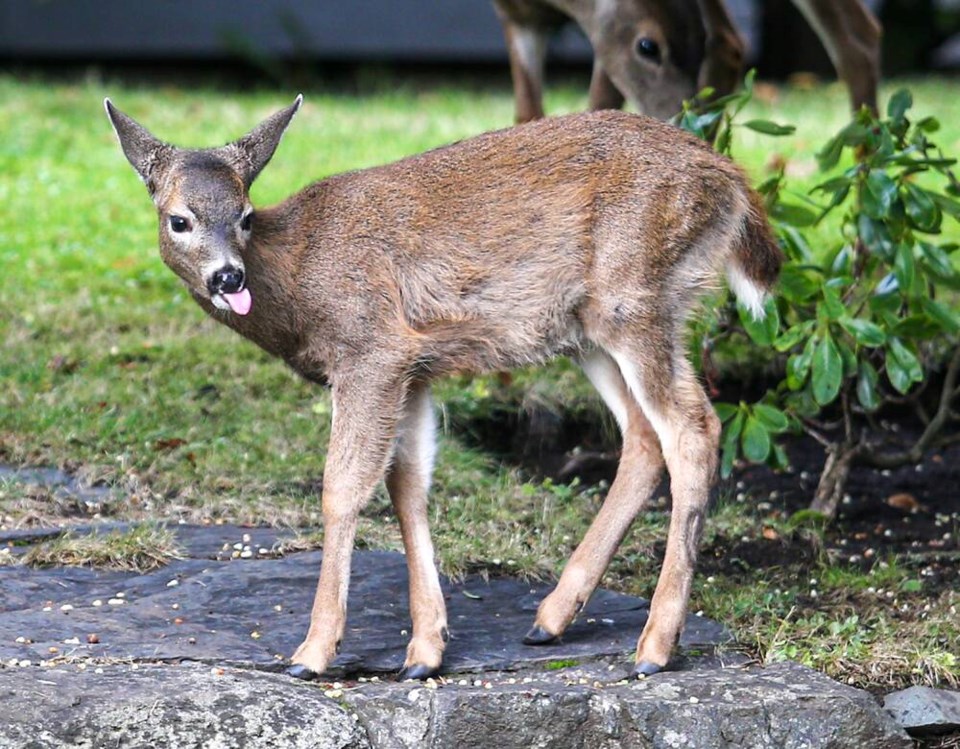Oak Bay’s birth-control program for deer is working.
An interim report posted online by the municipality this week shows a 60 per cent decrease in the number of fawns born in 2020, one year after the start of an immunocontraceptive vaccine pilot project.
“I find it really heartening that this seems to be an effective alternative to a cull as a means of population reduction,” wildlife biologist Alina Fisher said Tuesday. “It’s got the potential to help with urban deer management across the entire province. It’s fantastic. I’m pretty excited about the results.”
The University of Victoria PhD student in environmental studies is part of the research team for the Oak Bay Deer Project, a first-of-its-kind study that is attempting to reduce the number of wild black-tailed deer in the municipality.
Oak Bay, the province and the Urban Wildlife Stewardship Society, a non-profit society that promotes science-based and humane population management of urban wildlife, have been working on the project to slow the growth of the urban deer population.
In September 2019, 60 does were inoculated with an immunocontraceptive by veterinarian Dr. Adam Hering and a group of volunteers. The does were darted with a sedative before a dose of the vaccine was injected by hand. Two to six weeks later, the deer were given a booster. The study also included a control group of 20 does that were given collars, but not vaccinated.
In 2020, the 60 does were given booster shots. The vaccines are administered in the fall and researchers don’t see the results until spring or summer, said Fisher, who described the delay “excruciating.”
The research team has yet to analyze how many fawns were born in 2021 because fawns were born throughout the summer and it takes time to get the data, she explained.
Oak Bay’s adult deer population remains unchanged, but with fewer fawns, there should soon be a reduction, said Fisher.
“I’m hoping the province will find these are the results they are looking for and be able to say this is an approved method that can be used throughout the province,” said Fisher. “Right now, it’s a research project because it hasn’t been approved as a management method.”
Oak Bay Mayor Kevin Murdoch said the results look promising, but council still has to review the report.
The goal of the study was to convince the province the program was a viable approach to deer reduction that can be applied beyond Oak Bay, he said. “My hope is that the province will see these results and allow us to apply immunocontraception more operationally, as an annual program, and from that, be able to do that with our neighbouring municipalities as well.”
Murdoch expects council will discuss the report in December.
The Times Colonist asked the Ministry of Forests, Lands and Natural Resources for comment but didn’t immediately hear back.
Fisher said there is a wide range of opinion about urban deer, including how many is too many. “Many of us really love seeing wildlife in our backyard and some absolutely hate it and there’s a wide swath of people in between. I’m really curious at what point we’re going to come to agreement about how many deer are enough or too many or the right amount,” said Fisher. “I don’t know if we’re ever going to reach that point, but I hope we can find a happy medium.”
Esquimalt is also participating in the study. In June, the province granted the township a permit, and it began its immunocontraceptive program in September. The research is being done by the University of Victoria Applied Conservation Macro Ecology Lab, which will use the same methods to inoculate up to 100 female deer.





